23.2 Walkthrough: Creating Simple Diagrams
A new diagram is initiated through File\(\rightarrow\)New Diagram. This will pop up a window containing an empty canvas ready for drawing, similar to that in Figure ??.
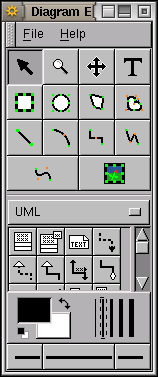
 The default new canvas ready for a new diagram. The right
mouse button clicked over the canvas contains a menu of all the
operations. {#fig:dia-untitled}
The default new canvas ready for a new diagram. The right
mouse button clicked over the canvas contains a menu of all the
operations. {#fig:dia-untitled}
The canvas is decorated with a grid to guide the drawing. The default grid is drawn every centimetre in both directions. Page borders are also shown as blue grids (the darker lines in Figure ??). Change the page margins for new diagrams with File\(\rightarrow\){Page Setup…}. Information on the current zoom level is displayed in the lower left.
We are ready to create our diagram. A simple entity relationship (or
ER) diagram will serve to illustrate the process. An ER diagram
illustrates the structure of a database and is an important tool in
database design. The basic diagraming elements of an ER diagram are
the entity (a rectangle), the relationship (a diamond) and the
attribute (an oval). There are variations to each of these that
identify different interpretations. These elements are connected with
either single or double lines. All these diagramming elements are
supplied by the ER sheet.
 %.
%.
Let’s put together a design for a Movies database that will store
information about movies and their stars. We have two
entities in our database: Movies and Stars. Entities are
represented pictorially as rectangles containing text that names the
entity. To create the entity Movie click on the Entity button
of the ER sheet.
 %
Then move the mouse pointer to the canvas and click again (with the
left mouse button) to place a rectangle containing a default label
(
%
Then move the mouse pointer to the canvas and click again (with the
left mouse button) to place a rectangle containing a default label
(Entity). You will now want to change the name of the entity
to Movie. To do this double click this entity with the left
mouse button to bring up the Object properties window. Now double click the word Entity that
 %
appears in the Name: text field and type
%
appears in the Name: text field and type Movie.
Click the Apply button and you will see the entity name
change on the canvas. You can click on OK or Close
to close the Object properties window if you wish.
Next we will create the attributes of this entity: a Movie has a
Title, the Year in which the movie was made, and the Length of the
movie. The procedure for creating attributes is the
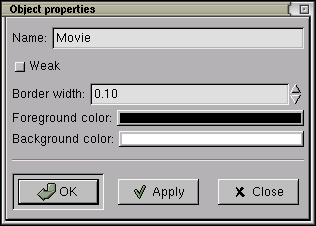 %
same as for all shapes. Select the Attribute tool (the oval) from the
ER sheet and click on the canvas where you would like to place the
Attribute. Double click this to edit the Object properties to change the Name of the attribute to
%
same as for all shapes. Select the Attribute tool (the oval) from the
ER sheet and click on the canvas where you would like to place the
Attribute. Double click this to edit the Object properties to change the Name of the attribute to Title.
This attribute is also going to be the attribute by which we uniquely
identify every movie in the database. This is called Key, so
select the Key checkbox. Click on the OK or
Apply button for this change to take effect.
 %
%
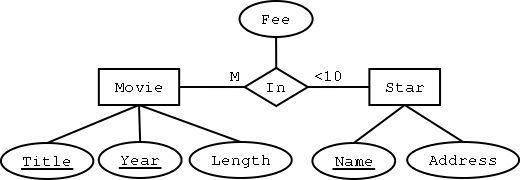
Sample entity-relationship diagram. {#fig:dia-er-sample}
Another diagram (Figure ??) uses UML shapes although it is not itself a formal UML diagram.
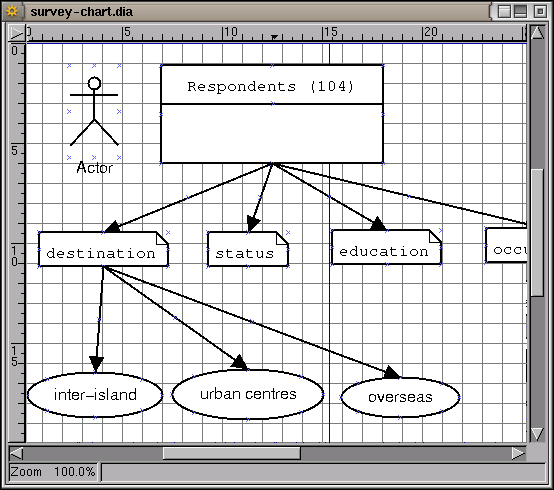
Sample diagram. {#fig:dia-survey-chart-window}
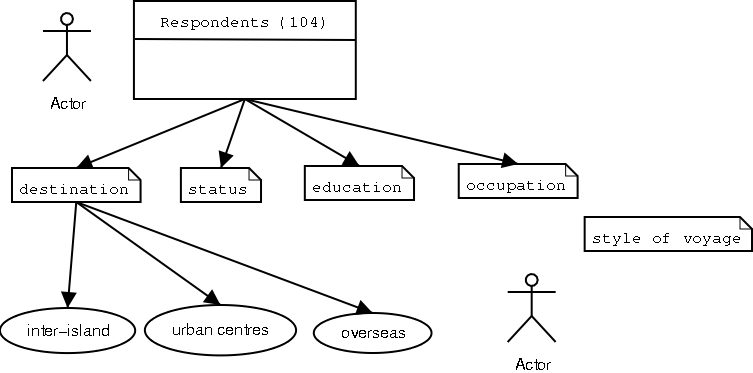 Sample diagram saved as a graphic and
imported into this book. {#fig:dia-survey-chart}
Sample diagram saved as a graphic and
imported into this book. {#fig:dia-survey-chart}
Your donation will support ongoing availability and give you access to the PDF version of this book. Desktop Survival Guides include Data Science, GNU/Linux, and MLHub. Books available on Amazon include Data Mining with Rattle and Essentials of Data Science. Popular open source software includes rattle, wajig, and mlhub. Hosted by Togaware, a pioneer of free and open source software since 1984. Copyright © 1995-2022 Graham.Williams@togaware.com Creative Commons Attribution-ShareAlike 4.0
